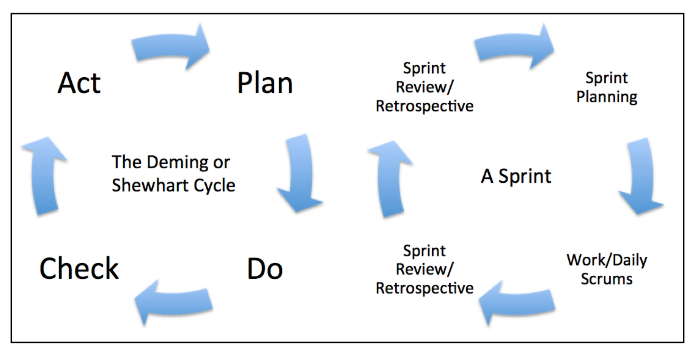How is Scrum Related to Plan-Do-Check-Act (PDCA) Process?
The concepts behind Scrum go even further back in time. In the 1950s, a management consultant by the name of W. Edwards Deming created the Plan-Do-Check-Act (PDCA) cycle as a framework for continuous improvement. PDCA, also known as the Deming or Shewhart cycle, had an early influence on Toyota’s lean approach to manufacturing.
These ideas map one-to-one to that of a Scrum’s sprint, and even to a sprint’s daily scrum, as indicated in the following figure and later in the book, but Deming didn’t know he was doing Scrum. Or more appropriately, perhaps, is that today’s Scrum teams don’t readily realize that they’re applying the Deming cycle!

When I was in the internal training of Scrum, some people asked a question: ” What is the difference between Scrum and Deming’s PDCA (Plan, Do, Check, Act) cycle? ” Roughly speaking,
Plan is the sprint planning meeting
Do is the sprint execution (together with Daily Scrum)
Check is the sprint review and retrospective, and
Act is the feedback result of the sprint review and retrospective, which is reflected in the specific requirements and process improvement activities.
Each PDCA cycle is like a Sprint. As time progresses, the quality of the team continues to improve through continuous improvement. Perhaps, we should consider that the PDCA cycle is only roughly mapping between the two, they cannot be fully corresponded to each other.
More Articles Relate to Scrum Activities
- What are the Scrum Events?
- What are Scrum Ceremonies?
- What is Product Backlog Grooming?
- What are the 3 Important Questions in Daily Scrum?
- Scrum Sprint Cycle in 8 Steps
- What is a Sprint in Scrum?
- Heartbeat of Scrum – The Daily Standup
- Daily Scrum Meeting – A Quick Guide
- Why Fixed Length Sprints in Scrum?
- What is Scrum Release Planning?
- What is Sprint Planning?
- What is Sprint Review?
- What is Sprint Retrospective Meeting in Scrum?